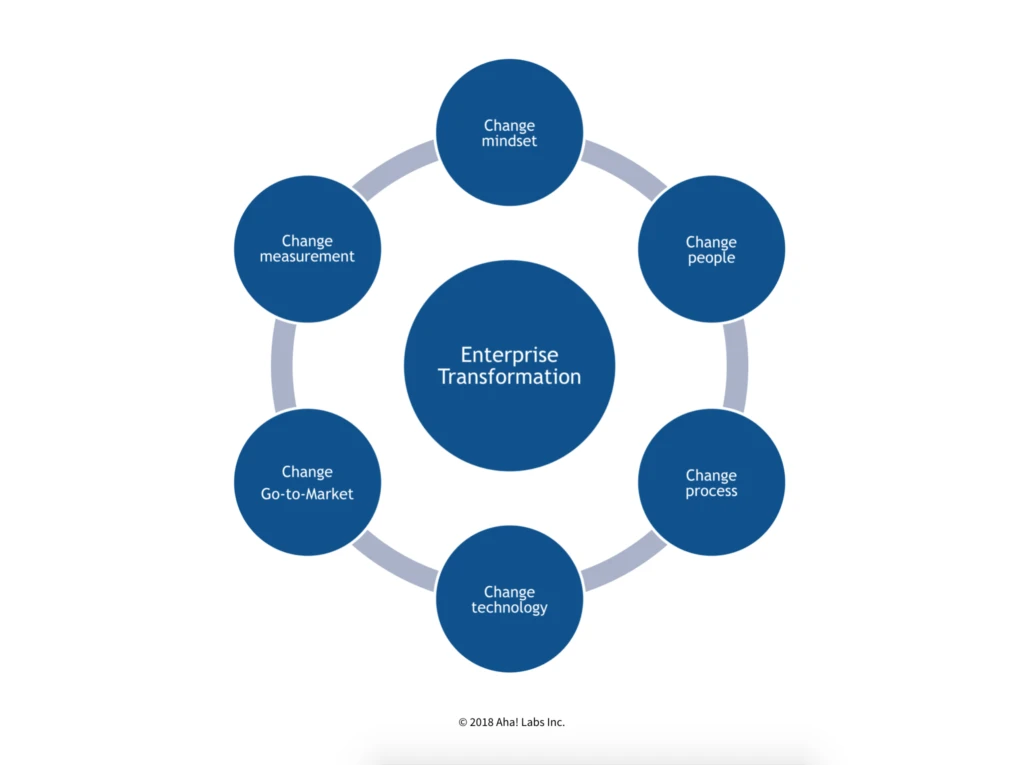
5 Skills You Need to Lead Enterprise Transformation
Enterprise transformation has been a popular topic on this blog lately. By now, you should be familiar with the framework I have laid out. And you may be wondering how it gets done. What can you actually do to have an impact at a company going through major change?
In one of my most recent posts, I explained how product managers are in a great position to drive change — whether the change needed is a digital, data, or solutions transformation. And I presented the steps shown below, which are required for a transformation to be successful across the entire organization.
Okay, but what work is needed to make real change? Enterprise transformation can be a massive and even daunting effort. This is especially true if you are the one championing change at your company. But if you are reading this, you already have one essential attribute needed for leading the effort — a desire to do it right.
You know what type of transformation is needed and why. Now your focus is on making it happen in practice.
There are specific skills that will serve you well as you seek to implement big change. Some of these leadership traits might already be part of your role. But you can also work on building areas where you are lacking.
Here are the five most important skills needed to lead an enterprise transformation:
Strategic planning You own the strategic plan that will help the organization deliver an exceptional new customer experience and improve how it operates. This requires a preternatural ability to spot challenges and opportunities — for example, understanding new ways that customers want to learn about, buy, and get help with your product. You must then be able to translate those learnings into tangible focus areas with goals and timelines.
Data analysis Guessing is not a plan. Data will give you the customer and market insights you need to plan your transformation efforts. Of course, you may not be the one actually analyzing the numbers, but you must be astute enough to know what type of data to gather and the metrics you will need to measure the progress of the plan. (Plus, building trust for a new approach is always easier when you back it with facts.)
Customer orientation To implement real change, you must deeply understand why the current way of developing and delivering your product might not be ideal. Conduct research and talk to customers to recognize gaps in your process. Then, work with cross-functional leaders to understand what new methodologies, technologies, and tools will help your company fill in those gaps and meet the strategic goals you have set.
Confident curiosity Keep up to date on new technologies, changes in customer preferences and behaviors, and what your competitors are doing. Be relentless about learning and improvement — it sets a tone for the organization. It is your responsibility to identify shifts in the market. When you find an area that is aligned with your goals and metrics, it is also your responsibility to share those vetted opportunities with the team.
Kindness and transparency You need these skills to lead no matter what. But empathy is especially critical in driving enterprise transformation because of the amount and size of change involved. Some people will have to flex in uncomfortable ways and learn new skills. Or you might bring in new hires, which could create some anxiety on the team. Use kindness and transparency to help everyone understand why the chosen transformation is your company’s path to the future.
Yes, an enterprise transformation is a lot of work. But you are not in it alone.
Remember that you are leading the effort — you are not changing the company all by yourself. With the right skills to guide the team and the right people backing you, your transformation will be a success.
What is the most important skill for leading organizational change?





